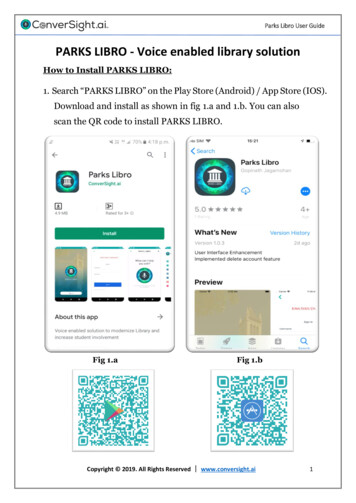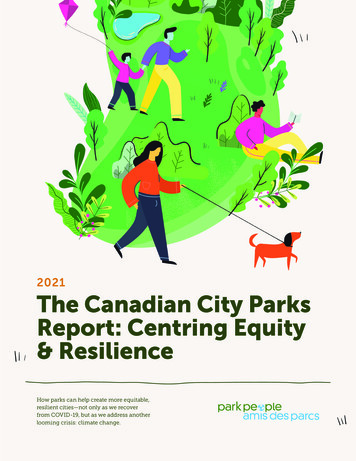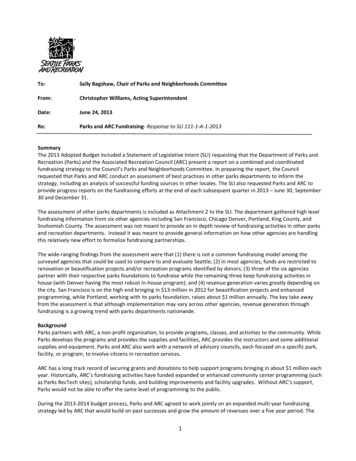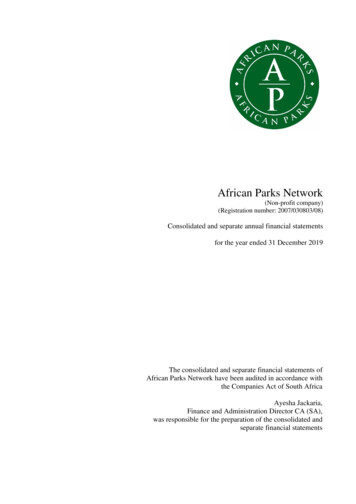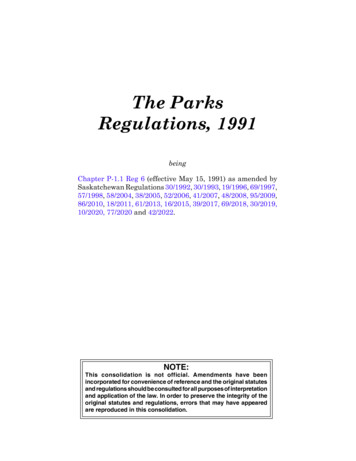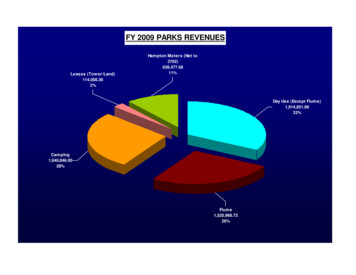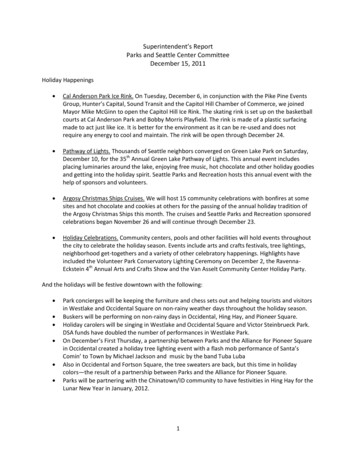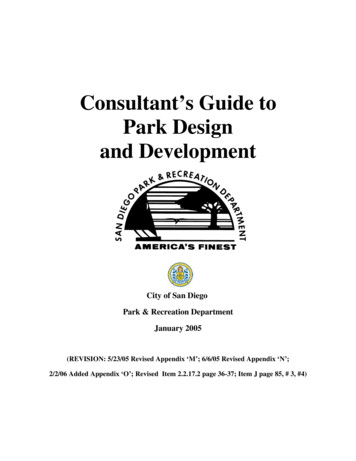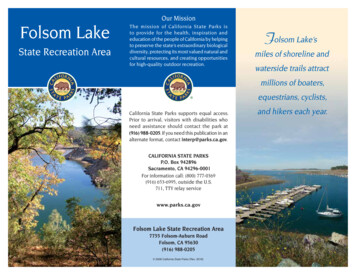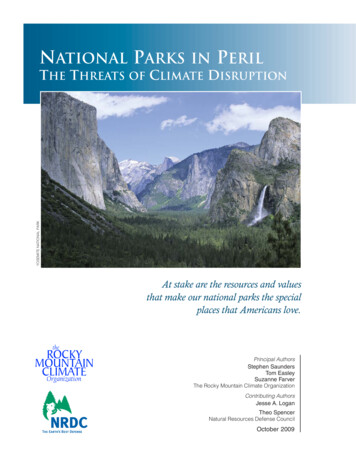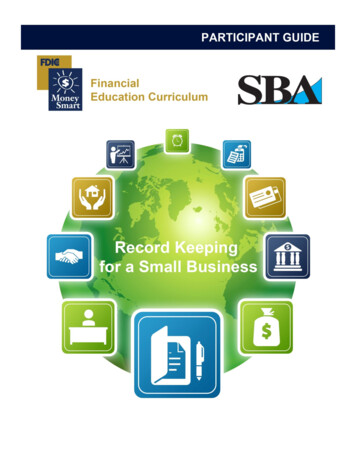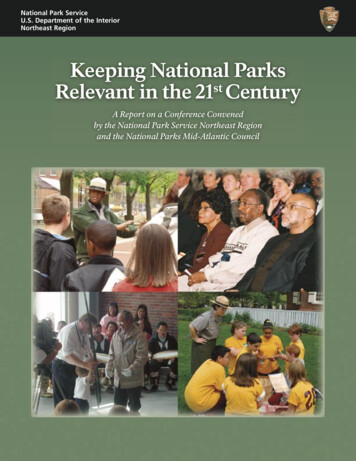
Transcription
National Park ServiceU.S. Department of the InteriorNortheast RegionKeeping National ParksRelevant in the 21st CenturyA Report on a Conference Convenedby the National Park Service Northeast Regionand the National Parks Mid-Atlantic Council
This report is the eighth in the Conservation andStewardship Publication Series produced by thePublications in the Conservationand Stewardship Series:Conservation Study Institute. This series includes avariety of publications designed to provide informationNo. 1 – Landscape Conservation: Anon conservation history and current practice forInternational Working Session on theprofessionals and the public. The series editor is Nora J.Stewardship of Protected Landscapes, 2001Mitchell, director of the Institute.No. 2 – International Concepts in ProtectedThe Conservation Study Institute was established by theLandscapes: Exploring Their Values forNational Park Service in 1998 to enhance leadership inCommunities in the Northeast, 2001the field of conservation. A partnership with academic,government, and nonprofit organizations, the instituteNo. 3 – Collaboration and Conservation:helps the National Park Service and its partners stay inLessons Learned in Areas Managed throughtouch with the evolving field of conservation and toNational Park Service Partnerships, 2001develop more sophisticated partnerships, new tools forcommunity engagement, and new strategies for theNo. 4 – Speaking of the Future: A Dialogue21 century. The Institute is based at Marsh-Billings-on Conservation, 2003stRockefeller National Historical Park within the NortheastRegion of the National Park Service.No. 5 – A Handbook for Managers of CulturalLandscapes with Natural Resource Values,We encourage you to share the information in this2003 (web-based)report, and request only that you give appropriatecitations and bibliographic credits.No. 6 – Collaboration and Conservation:Lessons Learned from National Park ServiceRecommended citation: Nora Mitchell, Tara Morrison,Partnership Areas in the Western UnitedVirginia Farley, and Chrysandra Walter, editors. KeepingStates, 2004National Parks Relevant in the 21 Century. Woodstock,stVermont: Conservation Study Institute, 2006.No. 7 – Reflecting on the Past, Lookingto the Future: Sustainability Study Report.For additional copies, contact:A Technical Assistance Report to the JohnConservation Study InstituteH. Chafee Blackstone River Valley National54 Elm StreetHeritage Corridor Commission, 2005Woodstock, VT 05091Tel: (802) 457-3368 / Fax: (802) 457-3405All publications are available in PDF format atwww.nps.gov/csiww.nps.gov/csi
Keeping National ParksRelevant in the 21st CenturyA Report on a Conference Convenedby the National Park Service Northeast Regionand the National Parks Mid-Atlantic CouncilatIndependence National Historical ParkPhiladelphia, PennsylvaniaOctober 14–15, 2005National Park Service Northeast RegionReport edited by Nora Mitchell, Virginia Farley, Tara Morrison, and Chrysandra WalterCompiled from meeting notes by facilitators Tammy Bormann and David Campt
21st-CenturyRelevancy: The NPS mission will be relevant to contemporary America throughengaging the public, developinga seamless network of parks, andprotecting America’s cultural heritage.
CO N T E N T SForeword Northeast Regional Director Mary Bomar v I. ƒ Designing the Conference and Preparing This Report1 II. ƒArticulating a Vision for the National Park Service in the 21st Century5 III. ƒLeading Change: Identifying Opportunities and Barriers in National ParkService Organizational Culture9 IV. ƒCharting a Way Forward: A Strategic Framework for Keeping National ParksRelevant in the 21st Century15 Epilogue: Next StepsNortheast Regional Director Mary BomarWorking Together to Lead Change through Accomplishing Actions,Assessing Progress, and Continually Renewing Our StrategyBibliography and Resource List18 20 Appendices ƒA. Conference Agenda21 B.22 Conference ParticipantsC. Personal Commitment and Action Plan24 D. Reports and Programs with Related Strategies and Action Plans24 E. Potential Ideas for Actions Identified at the Conference25
Sharing ideasis critical for us to be an effective, efficient, learning organization. Times have changed in the National Park Service’s almost 90 years, and we must change the way we work to keep usflexible, relevant, and successful. As you work with partners and seek new relationships, pleasereinforce these goals both in the ways you work together and the projects on which you embark. These broad goals will also be helpful in guiding your public message—so the communities ofwhich we are a part know where we are headed and feel invited and encouraged to join us. – Fran P. Mainella, DirectorNational Park ServiceNational Park Service Legacy Initiative“Doing Business in the 21st Century”Management ExcellenceThe National Park Service promotes managementexcellence and will epitomize governmentaccountability. We will be a highly transparentorganization whose productive, safe workforcereflects the diversity of our country and useseffective business practices to fulfill our corework.SustainabilityThe National Park Service will pursue sustainablefacilities, operations, business practices, andresources through conservation, design,fiscal responsibility, information technology,partnerships, philanthropic support, and positiverelationships with Congress.ConservationThe National Park Service will continue tobe a leader in natural and cultural resourceconservation, protection, restoration, andstewardship. We will accomplish our workthrough partnerships with educationalinstitutions, intergovernmental organizations atthe local, state, and federal levels, and interestgroups.Outdoor RecreationPeople’s enjoyment of and appreciation forthe National Park System are essential to itsconservation. The National Park Service embracesits critical responsibility to provide appropriateoutdoor recreation and to contribute to thephysical and mental well-being of all Americans.We will provide these opportunities both throughthe National Park System itself, and through ourrole in a seamless network of parks.21st-Century RelevancyThe mission will be relevant to contemporaryAmerica through engaging the public, developinga seamless network of parks, and protectingAmerica’s cultural heritage.Source: sJULY2005.pdfFACING PAGE: (center) Mary Bomar, NPS Northeast Regional Director;(right) Robert G. Stanton, Senior Fellow, Texas A & M University, Former Director, NPS; and (left) Jeffrey Leath, Pastor, Mother Bethel A.M.E. Church. ivKeeping National Parks Relevant in the 21st Century
FOREWORDNortheast Regional Director Mary BomarAs the National Park Service approaches its 90thanniversary, we look ahead to a new legacy forthe 21st century. “Relevancy in the 21st century”is a cornerstone of the National Park ServiceLegacy Initiative, “Doing Business in the 21st Century”(see box on facing page). This initiative creates a commonnational framework and encourages us to share our successesand learn from one another. In pursuing these goals, ouragency will create enduring connections with the Americanpeople; become increasingly effective, innovative, andentrepreneurial; and expand our partnerships with othersin order to fulfill the National Park Service purpose andmission (see below).National Park Service Purpose(from the Organic Act of 1916)To conserve the scenery and the natural and historic objects andthe wild life therein and to provide for the enjoyment of the samein such manner and by such means as will leave them unimpaired for the enjoyment of future generations.National Park Service Mission StatementThe National Park Service preserves unimpaired the naturaland cultural resources and values of the National Park Systemfor the enjoyment, education, and inspiration of this and futuregenerations. The Park Service cooperates with partners to extendthe benefits of natural and cultural resource conservation andoutdoor recreation throughout this country and the world.NPS Director Fran Mainella has asked the Northeast Regionto provide national leadership on 21st-century relevancy.Accepting this challenge, we need to think carefully aboutways to reach diverse communities more effectively bothhere in the region and across the United States. We mustthink not only about the stories we tell through our parksand programs but also about the faces we present to ourvisitors and neighbors, the ways we respond to changingdemographics, and how we forge new partnerships. Beingrelevant requires exceptional skills––listening, understanding,and meeting the evolving needs of the American public––andengaging people who do not yet have a relationship withtheir National Park System or for whom visiting nationalparks is a distant dream. “Doing Business in the 21st Century”will demand exceptional creativity—seeking out new ways tocommunicate and new ways to build commitment from thenext generation of stewards.In a recent message to all NPS employees, Director Mainellareminded us that parks are “places that affirm cherishedideas, ideals, and stories, and that also provoke questionsand expose visitors to unfamiliar perspectives” and that theNational Park Service is “an institution with a unique andvital role to play in telling America’s story and nurturing aninformed citizenry—a mission of high national purpose.”With this high purpose in mind, the Northeast Regionand the National Parks Mid-Atlantic Council conveneda conference, “Making National Parks Relevant in the21st Century” to bring people together to have a seriousconversation on relevancy and engaging an increasinglyKeeping National Parks Relevant in the 21st Centuryv
diverse population. This conference was clearly thebeginning of a much longer conversation. While this meetingemphasized African American life and culture, I foreseefurther conversations with other populations that can bebetter served by the National Park Service—through ourparks, our programs, and our partnerships. To build theNational Park Service of the 21st century we must strive tomake these conversations as inclusive as we possibly can.This meeting was an important milestone along this road—the journey will take time and will require us to sustain asteadfast commitment to change.This is, of course, not the first time that individuals haveworked to increase the relevancy of the National ParkService. The past, it is said, is the key to the future. In 1991,the National Park Service’s 75th Anniversary Symposiumlooked at ways to diversify our workforce of 20,000, tobroaden our stories, and to reach new groups of visitors, at atime when nearly 350 million people were visiting America’snational parks. Looking to the not-too-distant future, thesymposium predicted:Everyone will belong to a minority group. Whites will no longer bea majority group in several states (such as California); Asian andHispanic populations will dramatically increase, with Hispanicsoutnumbering African Americans by 2010. Politics will be altered;by 2000, most mayors in the nation’s big cities will be people ofcolor; racial-crossover voting will be common.The symposium’s report recommended that the NationalPark Service review its thematic framework and undertakestudies for new additions that would better reflect theheritage, stories, and cultures of an increasingly diversepopulation.During NPS Director Bob Stanton’s tenure, I had theprivilege of working with him on a national committee oninstitutionalizing diversity and had the opportunity to betterunderstand the agency’s challenges. Many of the issues I sawthen are still with us today. Our workforce diversity is not allthat it could be and there is still an imbalance between theNPS workforce today and the “face of America.”In 2001, the National Park System Advisory Board’s report,Rethinking the National Parks for the 21st Century, also focusedon this growing challenge. The advisory board was thenchaired by historian John Hope Franklin—a great thinkerand a most humble man despite his many accomplishments.And while the report was the work of many, I like to thinkthat it was he who penned these words:viKeeping National Parks Relevant in the 21st CenturyThe public looks upon national parks almost as a metaphor forAmerica itself. But there is another image emerging here, a pictureof the National Park Service as a sleeping giant—beloved andrespected, yes; but perhaps too cautious, too resistant to change, tooreluctant to engage the challenges that must be addressed in the 21stcentury. The Park Service must ensure that the American story istold faithfully, completely, and accurately. The story is often noble,but sometimes shameful and sad. In an age of growing culturaldiversity, the Service must continually ask whether the way inwhich it tells these stories has meaning for all our citizens.I want to thank our conference co-sponsor, the NationalParks Mid-Atlantic Council, and its members for theirleadership and hard work in convening this dialogue. Thisconference would never have been planned nor organizedthe way it was without their guidance. For the fruition ofthis effort, credit is due to a number of people, includingPatricia Conway, Lauranett Lee, and Bill Withuhn of theMid-Atlantic Council, and NPS Northeast Deputy RegionalDirector Sandy Walter and Superintendents Edie SheanHammond, Cynthia MacLeod, and Gay Vietzke.We also thank our partner, Eastern National, for itscontinuing support and for assistance with preparation ofthis conference report. All of the conference participants aregrateful for the excellent guidance in planning the meetingand the skill in facilitating the dialogue provided by TammyBormann and David Campt. I offer sincere gratitude to all ofour speakers who contributed so much wisdom and adviceto enhance our collective understanding. In particular, Iwant to express my deep appreciation and admiration forformer NPS Director Robert Stanton, John Franklin ofthe Smithsonian Institution, and Reverend Jeffrey Leathof Mother Bethel A.M.E. Church for their personal andprofessional commitment. I also recognize the commitmentof the participants and look forward to working with themas we follow up on the ideas generated by this conference.Finally, I want to thank the Conservation Study Institute andthe editors of this report who successfully summarized thismeeting so that we may build our future conversations andactions upon this dialogue.This is an exciting time in the National Park Service and welook ahead to enormous opportunities as we help shapethe NPS of the future. The park superintendents and ourpartners who participated in this conference have createda vision for the National Park Service in the 21st century. Tomake this vision a reality will require all of us to lead changenot only at our parks and in our communities, but with ourpeers in the region and the nation. We must all work togetherso that all Americans can experience their heritage.
Section I.Designing the Conferenceand Preparing This ReportConferenceparticipants at“MakingNational ParksRelevant in the21st Century,”October 14-15,2005 inPhiladelphia.
D E S I G N I N G T H E CO N F E R E N CEA. Meeting GoalsIf a journey begins with a single step, this quest for21st-century relevancy began with a conversation. Theconference, “Making National Parks Relevant in the 21stCentury,” was designed to be a “foundational conversation”for an ongoing dialogue on the relevancy of national parksand programs in the Northeast Region. Developed incooperation with the National Parks Mid-Atlantic Council,the two-day gathering provided a forum to reflect on anddiscuss issues of relevancy and diversity, from demographicsto first-person accounts of affecting change (see conferenceagenda in appendix A).In her opening remarks, Northeast Regional Director MaryBomar described this forum as an opportunity for leadersfrom the Northeast Region of the National Park Serviceand their many partners to work together to create a roadmap toward relevancy in the 21st century. Conferenceparticipants included NPS managers, nonprofit partners,scholars, museum professionals, and others (see participantlist in appendix B). This conversation intentionally surveyedthe contemporary American landscape, with a particularemphasis on African American life and culture. Themeeting was designed to create and sustain a commitmentto change through individual and collective actions, futureconversations, and the monitoring of progress over time.The outcomes described in this report express a collectivevision for the National Park Service in the 21st century, anunderstanding of the current opportunities and challenges,and a strategic framework to guide actions that will enhancethe connections between NPS and an increasingly diverseAmerican public.B. A Guide to This ReportTo accomplish the meeting goals, facilitators TammyBormann and David Campt led participants through aseries of sessions that included personal reflection, smallgroup and plenary discussions, and presentations (see themeeting agenda in appendix A). The table on the facing pagedescribes the flow of the meeting and the correspondingsections in this report.Conference participants at “Making National Parks Relevant in the 21st Century,” October 14-15, 2005.2Keeping National Parks Relevant in the 21st Century
The voices in this report are primarily those of conferenceparticipants. The meeting facilitators recorded somedirect quotes and short phrases of key ideas and providedsummaries of the discussions throughout the meeting, andthis report draws from those notes. The editors have strivedto reflect and summarize the dialogue, insights, and “groupwisdom” with minimal alteration.emerged in the discussion and are retained in this report.Many participants expressed the belief that a commitmentto continuing this conversation will ultimately produce arealistic road map to guide the quest for relevancy in the 21stcentury by the National Park Service and its partners in theNortheast Region.Since this was an open and honest dialogue, the readerwill find both optimism and pessimism, and laudatorypraise and harsh criticism. These contrasting perspectivesTable 1Agenda TopicPresentation or Question Posed by FacilitatorsReport SectionOverarching questionsof the conference1. What are the key strategic priorities that the NPS in the Northeast Region mustaddress in order to achieve its vision of organizational relevance in the 21st century,particularly to communities of color?All2. What are the key priorities for action that NPS sites in the Northeast Regionmust embrace in order to become more relevant to diverse communities in the 21stcentury?3. What are the key priorities for professional and individual growth of NPSleaders and employees in the Northeast Region that must be addressed in order tobuild capacity to achieve the organization’s vision of 21st-century relevancy?Remarks of Northeast Regional Director Mary BomarForewordRemarks by Bill Withuhn and Lauranett LeeAllWhen the NPS achieves its vision of 21st-century relevancy, how will the generalpublic describe the NPS? What will the NPS be known for?Section IIPanel Presentation: John W. Franklin, Robert Stanton, Reverend Jeffrey Leath, andCynthia MacLeodAllLessons learned:experience from thefieldHarvey Bakari and Larry Earl, Colonial Williamsburg FoundationPanel Discussion: Gay Vietzke, Tara Morrison, Vidal MartinezPanel Discussion: Dennis Reidenbach, Gillian Bowser, Alan Spears, George PriceAllLeading change:identifyingopportunities andbarriersWhat are ways the NPS organizational culture supports our progress on 21stcentury relevancy? What are ways the NPS organizational culture inhibits ourprogress?Section IIIWhat can my organization and I do to support the NPS as it seeks to move throughan organizational change process to achieve 21st-century relevancy? What do weneed from NPS leadership at regional and national levels to support our personalgrowth in order to become more effective NPS leaders in the 21st century?Section IV,EpiloqueCharting a wayforwardIdentifying strategic areas for action and next steps in the Northeast RegionSection IV,EpilogueSetting the stageArticulating the visionSecion I. Designing the Conference3
FACING PAGE:A. Conference participant at “MakingNational Parks Relevant in the 21st Century,”October 14-15, 2005, in Philadelphia.B. Preserving Memory Seminar participantsat Richmond National Battlefield Parkdiscussing race and civic dialogue withPaige L. Chargois from Hope in the City.C. NPS Northeast Regional DirectorMary Bomar addresses a dedicationceremony for a permanent exhibit at theNational Constitution Center providing anintroduction to the diverse mix of peoplewho lived and worked on the site around thetime of the American Revolution.D. Community expressions of loss at theOklahoma City National Memorial.E. Former World War II Tuskegee Airmanpilot cadet Ernest Haywood (on right) at hishome in Detroit, Michigan during an oralhistory interview by NPS historian WorthLong (Bill Mansfield, NPS photograph).4Keeping National Parks Relevant in the 21st Century
Section II.Articulating a Vision forthe National Park Servicein the 21st CenturyABCEBD
A R T I CU L AT I N G A V I S I O NWhen the NPS achieves its vision of21st-century relevancy, how will thegeneral public describe the NPS?What will the NPS be known for?A vision for the National Park Service in the 21st centurywas created by conference participants when asked the abovequestions.In this description of the 21st century vision, present tenseis used to directly state future intentions and to provideencouragement to achieve them.In the 21st century, Êthe National Park Service: Ê works in partnership with othersto tell inclusive stories relevant to allmembers of society and encouragesothers to tell their own stories; engages in ongoing dialogue with openness, sensitivity, and honesty; sustains community relationships; and creates a workforce reflective of society. In the 21st century, the National Park Serviceworks in partnership with others to tell inclusivestories relevant to all members of society andencourages others to tell their own stories.A relevant NPS includes all the stories of heritage that definethis country. These stories are interwoven—not isolated fromeach other—to create a bold, truthful narrative, and manypeople and many cultural groups tell their own stories.The NPS creates an atmosphere of trust so that complexand challenging stories can be shared and understood. Manycommunities that did not find meaning in the national parksduring 2006 are now actively engaged as a result of newavenues of communication created by the NPS. The messageand meaning of national parks is transformed, as is theworkforce.The National Park System encompasses many places thatreflect the country’s diversity. Alan Spears of the NationalParks Conservation Association noted that “the NPS is oneof the largest ‘custodians’ of African American history in thecountry.” Parks serve as venues for articulating many morenarratives, and create a variety of opportunities for peopleto forge meaningful connections. By developing knowledgeand awareness that span racial and cultural boundaries,new stories are created, forgotten ones rediscovered, andsociety strengthened. Bob Stanton observed, “The futureof the organization is fully dependent on the NationalPark Service’s validity and relevance to all people and itsability to articulate the entire story.” Reverend Jeffrey Leathadded, “There is a difference between information and interpretation. Relevancy does not alter information (facts); but itmay inform interpretation (the meaning we give facts). Reinterpreting to cater to a changing demographic or politicalenvironment will destroy credibility. Relevancy cannotreplace truth as the primary core value.”Conference Participant Quotes:The NPS presents a diverse continuum of the nation’s story inlandscape, heritage, and culture and serves as a partner andfacilitator to engage people in telling their own stories.The NPS engages in dialogue about the complete story ofAmerican history.6Keeping National Parks Relevant in the 21st Century
A tension between the “big story” and the supporting storiesremains. The challenge is how to get the big message acrossand to be prepared to share the supporting nuances whichwill be of most interest to diverse audiences.Visitors see park stories and park events through the eyes ofall who were a part of history.The NPS is a living encyclopedia of America’s heritage.The NPS is known for its depth of knowledge and its abilityto talk about controversial parts of our history and ourcompelling stories.The NPS is known for its sound, reasonable scholarship andacknowledges the “power of place” by providing hands-on,multi-sensory, learning opportunities.NPS is seen as an agency that does not buckle under politicalpressure but remains truthful to the facts and open toreinterpretation of those facts.NPS is known for facilitating and provoking thoughtfuldiscussions on sensitive issues.NPS units are sought out and recognized by all as safe,relevant places to visit for recreation and inspiration.NPS provides creative and innovative approaches forengaging all.In the 21st century, the National Park Servicesustains community relationships.Our national park system is for all, forever.In the 21st century, the National Park Serviceengages in ongoing dialogue with openness,sensitivity, and honesty.A National Park Service relevant to diverse groups of peopleis trusted to tell stories faithfully, completely, and accurately.Credibility and flexibility are part of achieving this vision.Recognizing that many challenging topics may still causediscomfort and that this is part of the process of opennessand honesty, it is critical to create safe environmentsfor dialogue. Richmond National Battlefield Park Superintendent Cynthia MacLeod noted that “ the fear that keptthe slave system in place is similar to the fear that keeps usfrom talking about race and its impacts today.”Conference Participant Quotes:The NPS mission itself as well as many resources under NPSstewardship transcend political and ownership boundaries,creating opportunities for close relationships with manycommunities nearby and across the country. Many naturaland cultural resources and related stories are inextricablylinked with neighboring communities and the vitality ofstorytelling depends on sustaining these connections. Inaddition, there are communities across the country that areinvested in the narratives and the natural and cultural historyof national parks, and that derive knowledge and enjoymentfrom and feel close connections to these parks—even somethey may never visit.For genuine relationship-building to occur, communityengagement requires the investment of intellectual as well asemotional energy. The result of these investments leads tomany intended and unintended positive outcomes.Conference Participant Quotes:NPS is a welcoming and trustworthy guardian of nationaltreasures and a storyteller that is inspiring to all people.The NPS is a catalyst for involvement, communityengagement, and stewardship.Americans look to the NPS to tell the story of heritage andknow that the NPS will be honest about that heritage.The NPS is known for celebrating stories of all citizens andbeing a welcoming presence in the community.NPS is both comfortable—everyone feels welcome—anduncomfortable, as many stories are challenging to discuss.The NPS is known to be an integral part of the community,particularly in urban settings.NPS staff facilitates a broad community dialogue aboutvalues without clouding the process with their own values.Secion II. Articulating a Vision7
NPS programs and staff are visible in many communities,and this visibility includes our own interwoven stories.Members of the general public feel accepted, acknowledged,connected, respected, and valued when they visit NPS sites.The NPS functions as a dynamic, interconnected wholerather than as a series of disconnected sites.The NPS has moved beyond the narrow path of the agencyand has partnerships with other organizations whosemissions are similar and aligned, and also have complementary expertise.In the 21st century, the National Park Servicecreates a workforce reflective of society.As demographics change, the NPS workforce changes, andthe agency continually strives to attract the best and brightestof each generation. There are, of course, challenges toachieving workforce diversity. As John W. Franklin noted,“Changing the NPS institution will require direct engagementwith others to fuel personal learning .The resistance theNPS experiences from ‘within’ will be as significant asthe resistance it experiences from ‘without.’” Bob Stantonagreed: “Without the will, the change is not possible.” Tocreate the will and overcome the fear and discomfort thatare necessary for real change to occur, the NPS providesprofessional development opportunities, offering individualsthe knowledge and support to make change. The NPS is alearning organization that is consistently evaluating programsand adapting to changing needs in society.Conference Participant Quotes:The NPS workforce is welcoming and representative of thepopulation of the U.S.Young people see NPS as a career goal and a place thatwelcomes all faces.The NPS is an employer-of-choice for diverse, high-caliberindividuals.NPS s serves as a caretaker and a learning organizationfor all people by being inclusive, open to change, accurate,truthful, responsive, respectful, and innovative.8Keeping National Parks Relevant in the 21st CenturyFACING PAGE:A. Visitors to Independence National HistoricalPark at the archeological site of the home ofJames Dexter, an 18th century African Americanleader, discussing his role as a prominent memberof the Free Afric
century. "Relevancy in the 21. st . century" is a cornerstone of the National Park Service Legacy Initiative, "Doing Business in the 21 Century" (see box on facing page). This initiative creates a common national framework and encourages us to share our successes and learn from one another. In pursuing these goals, our
